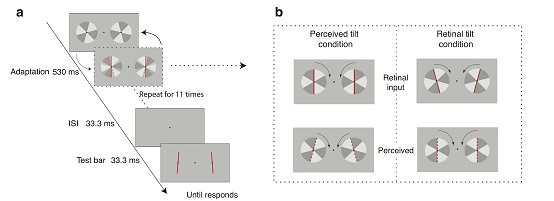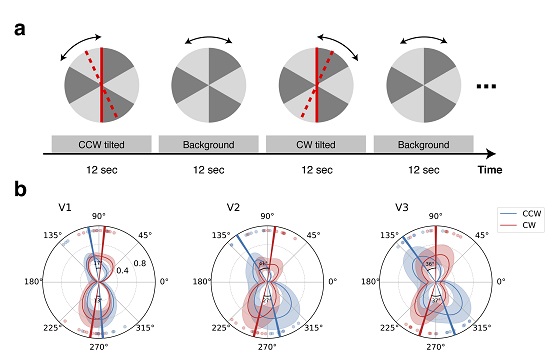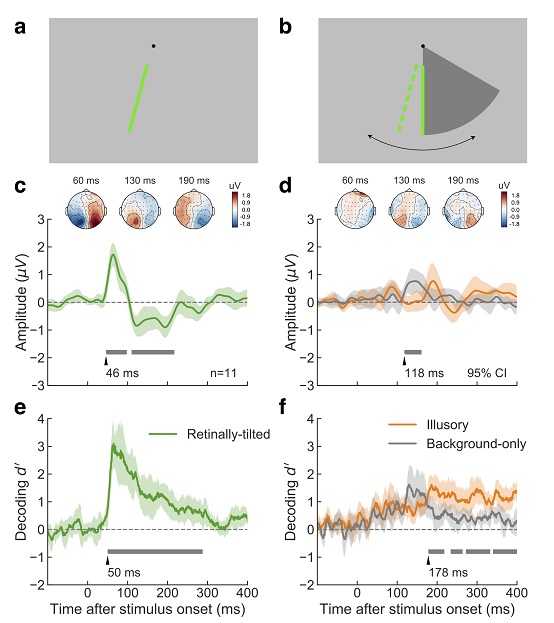Visual sensitivity adaptation depends on feedback signals from the representation of visual perception
The journal of Nature Communications on August 6 published latest findings by the team of Prof. HE Sheng with the State Key Laboratory of Brain and Cognitive Science at the Institute of Biophysics (IBP), the Chinese Academy of Sciences. The article, titled "Adaptation to feedback representation of illusory orientation produced from flash grab effect", explains that feedback signals in visual cortex play an important role in the orientation-selective adaptation of visual perception.
Adaptation is a ubiquitous property of the neural system, particularly the sensory system. It is generally believed that neurons will become adapted to dominant energies in the ambient environment to function optimally. However, the representation of input stimulus in the cortex is typically modulated by feedback signals and sometimes does not correspond to feedforward input state of the stimulus. The research was designed to demonstrate the relative contributions to visual adaptation from feedforward and feedback signals in visual cortex.
During their psychophysics experiments, researchers found that the adaptation of human vision to orientation signals depends on perceived rather than retinal input orientation. The conclusion was drawn from the orientation adaptation generated among subjects in the measured flash-grab effect (FGE). The tilt after-effect (TAE) is a visual phenomenon in which research targets are inclined to perceive a vertical bar as tilted away in a reversal of direction after they have been allowed to watch an adapting bar, whose orientation is actually tilted in a minor degree, again and again. There would be no TAE if research targets were allowed to repeatedly view vertical bars at the beginning. The question is whether the TAE will still occur when visual illusion induces research targets to view a vertical bar as tilted away. The FGE has provided a channel to dissociate the input from perceived orientation of the adapting bars and indicated that a vertical bar will be unconsciously viewed as tilted.
Researchers employed a visual stimulus induced in an experiment over vision adaptation to monitor the TAE. They found that there will be no TAE when a tilted bar is perceived as vertical and that the TAE will take place when a vertical bar has been viewed as tilted. Therefore, they concluded that the TAE depends on the perceived rather than retinal input orientation.

Figure 1: An experimental diagram of adaptation orientation after-effect induced by adaptation stimulus under the FGE
During their high spatio-temporal resolution human brain imaging experiments, researchers found that the representation of perceived orientation in the FGE of the cortex is primarily dependent on feedback signals. In addition, they also discovered in the 3T and 7T FMRI (functional magnetic resonance imaging) that the representation of perceived orientation in the FGE of the early cortex areas is significantly stronger in the V2 and V3 than in V1 and that the representation of perceived orientation in the superficial layer of the V1, which is dominant with feedback signals, is stronger than that in its middle and deep layers. A milli-second resolution recording of electrical activities in the brain showed that compared with feedforward orientation signals in the early processing stage of the cortex, the signals corresponding to perceived orientation in the FGE take place in the late stage of information processing in the cortex. Findings from the above-mentioned brain imaging indicated that the representation of perceived orientation in the early cortex areas depends on feedback signals.

Figure 2: Representation of the orientation of flashed bars in the FGE of early cortex areas

Figure 3: Signals of electrical activities induced by orientation information in the FGE
(Image by Dr. HE Sheng's group)
To sum up, the research employed the FGE induced by visual illusion to dissociate input from the perceived orientation and found that the TAE depends on the perceived rather than input orientation. The usage of high spatio-temporal resolution human brain imaging technology showed that the representation of illusory orientation in the FGE of the cortex comes from feedback signals, revealing that feedback signals play a leading role in the process of visual orientation when there are discrepancies between feedforward and feedback signals in the cortex.
Prof. HE Sheng and Dr. WANG Lan, also with the State Key Laboratory of Brain and Cognitive Science at the IBP, are correspondence authors of the paper. GE Yijun, ZHOU Hao and QIAN Chencan are its co-first authors. Researcher ZHANG Peng also makes great contributions to the research. It has received financial assistance from the National Natural Science Foundation of China, Beijing Municipal Science & Technology Commission Key Programs, and the Strategic Priority Research Program of the Chinese Academy of Sciences.
Article link: https://www.nature.com/articles/s41467-020-17786-1
Contact: HE Sheng
Institute of Biophysics, Chinese Academy of Sciences
Beijing 100101, China
Email: shenghemn@gmail.com
(Reported by Dr. HE Sheng's group)

